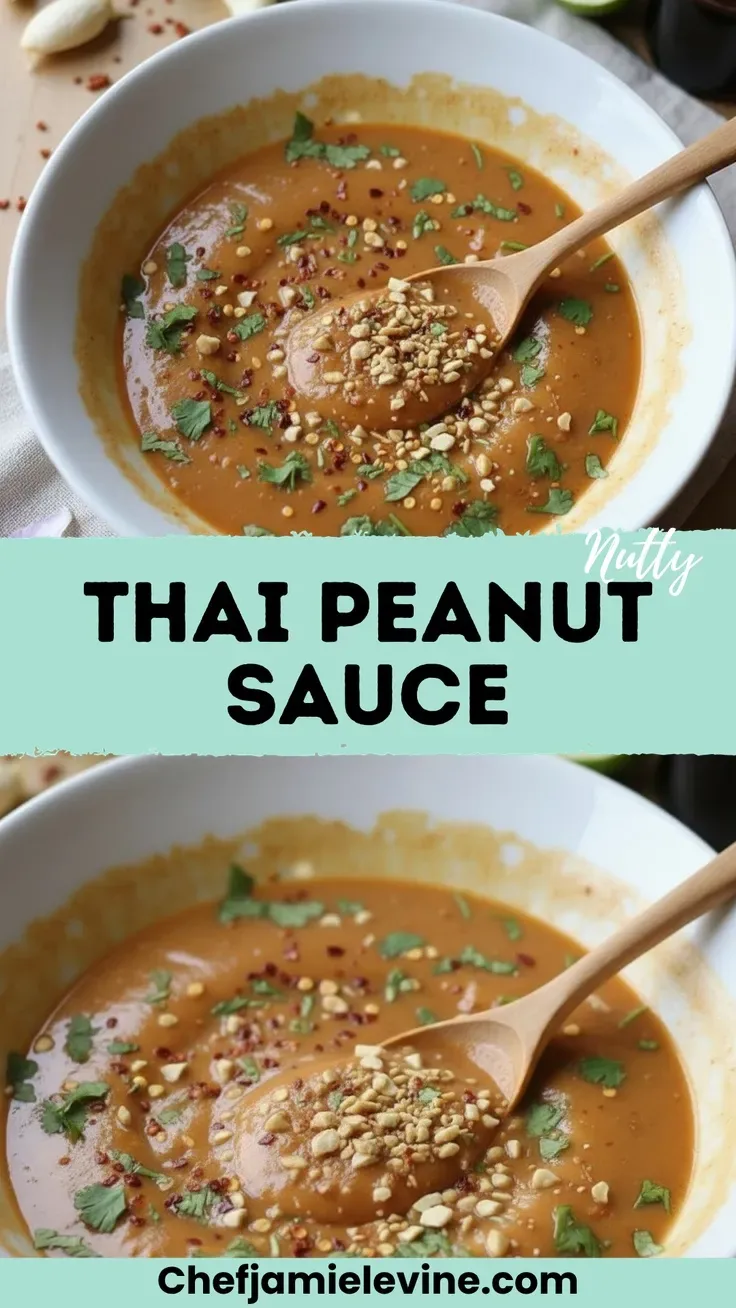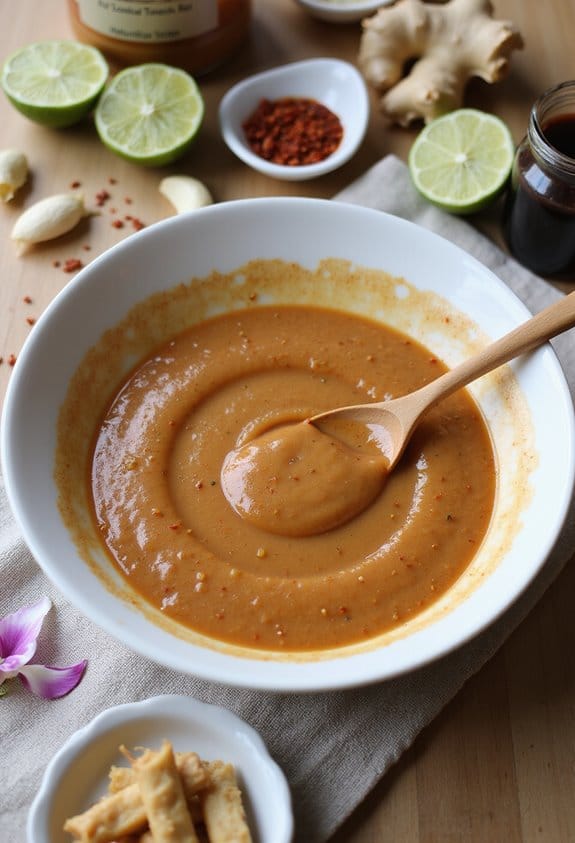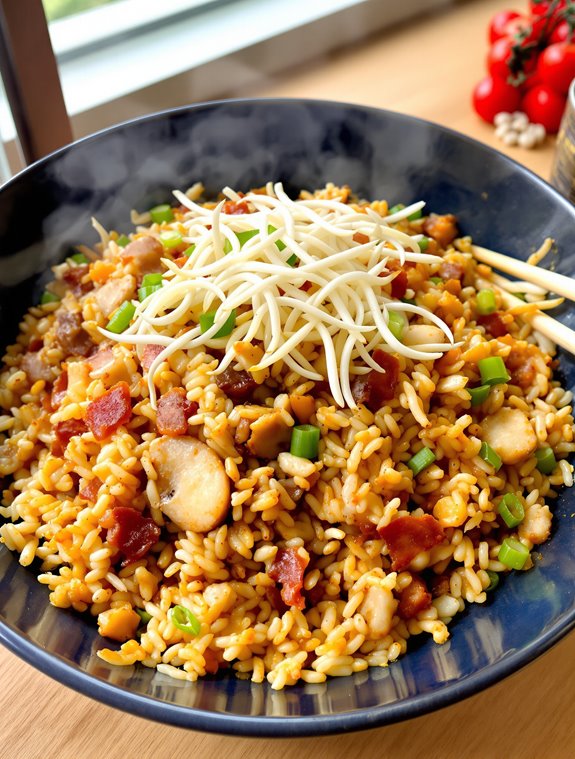Why You’ll Love this Thai Peanut Sauce
Every home cook needs this versatile Thai peanut sauce in their recipe collection.
I’ve been perfecting this one for years, and it never fails to impress. Creamy, savory, with just the right balance of tang from lime juice and warmth from ginger—it transforms ordinary meals into something special.
What makes it truly indispensable? It’s ridiculously adaptable. Drizzle it over noodles, use it as a dipping sauce for spring rolls, or thin it out for the perfect salad dressing.
Got dietary restrictions? No problem. Swap in sunbutter for nut-free or coconut aminos for soy-free versions.
Simply put, it’s kitchen magic in a jar.
What Ingredients are in Thai Peanut Sauce?
Creating authentic Thai peanut sauce at home is surprisingly simple, and the results are far better than anything you’ll find in a jar at the store. This recipe uses everyday pantry staples to create that perfect balance of creamy, savory, tangy, and just a touch sweet that makes Thai peanut sauce so irresistible.
The beauty of making it yourself is controlling exactly what goes in—no preservatives or mystery ingredients, just pure flavor that brings that restaurant-quality taste right to your kitchen.
- 1/2 cup creamy peanut butter
- 3 tablespoons warm water (plus more to adjust consistency)
- 2 tablespoons soy sauce (or tamari/coconut aminos for gluten-free)
- 2 tablespoons fresh lime juice
- 1-2 teaspoons honey or maple syrup
- 1 teaspoon toasted sesame oil
- 1 small garlic clove, finely grated
- 1/2 teaspoon grated fresh ginger (optional but recommended)
- Pinch of red pepper flakes or 1 teaspoon sriracha (to taste)
This recipe is incredibly accommodating for dietary needs and preferences. Need it nut-free? Simply swap in sunflower seed butter at a 1:1 ratio.
Avoiding soy? Coconut aminos with a pinch of salt works perfectly. You can even amp up the umami factor by adding a teaspoon of fish sauce (though this makes it non-vegan) or a bit of miso paste for a vegan-friendly umami boost.
The sauce will thicken when refrigerated, so just add a splash of warm water or extra lime juice to bring it back to your desired consistency before serving.
How to Make this Thai Peanut Sauce

Making this Thai peanut sauce couldn’t be simpler, and the process takes just minutes from start to finish.
Begin by adding 1/2 cup of creamy peanut butter to a medium bowl, then pour in 3 tablespoons of warm water. The warm water is key here—it helps break down the peanut butter, making it much easier to whisk into a smooth consistency.
Keep whisking until the mixture loosens up and becomes silky. Sometimes I find myself daydreaming about how satisfying it’s to watch thick peanut butter transform into a pourable sauce right before my eyes.
Now for all those beautiful flavors that make Thai peanut sauce so crave-worthy. Whisk in 2 tablespoons soy sauce (remember, tamari or coconut aminos work great for gluten-free folks), 2 tablespoons fresh lime juice (please use fresh—the bottled stuff just isn’t the same), 1-2 teaspoons honey or maple syrup depending on how sweet you like it, and 1 teaspoon toasted sesame oil.
Add 1 small finely grated garlic clove and 1/2 teaspoon grated fresh ginger if using. The ginger is technically optional, but why would you skip something that adds such wonderful warmth and complexity? Finally, spice lovers can add a pinch of red pepper flakes or about 1 teaspoon of sriracha to taste.
For the perfect consistency, you might need to adjust with a bit more warm water. Want a thinner sauce for noodles? Add water gradually until it reaches that perfect drizzling consistency. For a thicker dip, use less.
The sauce will thicken considerably in the refrigerator, so don’t worry if it seems a bit thin at first. When you’re ready to serve, give it a quick whisk with a little warm water or lime juice if needed to loosen it back up.
And there you have it—a versatile sauce that’s ready to transform everything from simple vegetables to protein-packed satay into something truly special.
Thai Peanut Sauce Substitutions and Variations
This sauce welcomes a world of adaptations based on your dietary needs or what’s available in your pantry.
Need a nut-free version? Sunflower seed butter works perfectly as a 1:1 replacement. I’ve made it for friends with allergies and they couldn’t tell the difference.
Going soy-free? Swap in coconut aminos with a pinch of salt.
For extra depth (which I sometimes crave on lazy weeknight noodles), add a teaspoon of fish sauce or miso paste.
When making ahead, don’t panic if it thickens in the fridge—just whisk in warm water or a splash of lime juice to bring it back to life.
What to Serve with Thai Peanut Sauce
While a great Thai peanut sauce stands perfectly well on its own, knowing what to pair it with can elevate your entire meal experience.
I love drizzling it over rice noodles or soba for an instant flavor upgrade, or using it as a dipping sauce for chicken satay skewers—a match made in culinary heaven.
Got spring rolls? Trust me, they’re begging for this sauce.
Raw veggies like bell peppers, carrots, and cucumber transform from boring to brilliant.
And don’t sleep on using it as a salad dressing—just thin it out a bit more.
My dinner guests always ask for the recipe, can’t blame them.
Final Thoughts
After experimenting with countless sauce recipes over the years, I’ve found that Thai peanut sauce remains one of the most versatile additions to any home cook’s repertoire.
It transforms ordinary ingredients into something truly special—whether drizzled over roasted vegetables or used as a quick noodle sauce for those nights when cooking feels like climbing Everest.
What makes this sauce so perfect? It’s the balance. Sweet, savory, tangy, spicy—all working together in creamy harmony.
The beauty is in its adaptability too. Make it your own. Adjust the heat, play with the thickness, swap ingredients based on dietary needs. Your kitchen, your rules.




